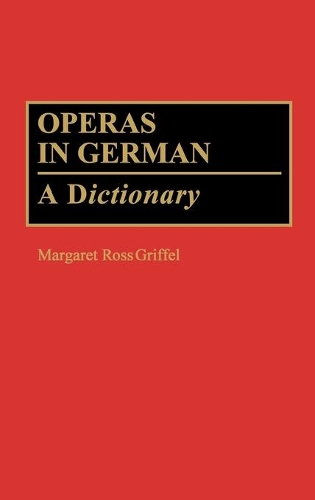
Operas in German: A Dictionary
(Hardback)
Publishing Details
Operas in German: A Dictionary
By (Author) Margaret R. Griffel
Bloomsbury Publishing PLC
Greenwood Press
30th November 1990
United States
Classifications
General
Non Fiction
Bibliographies, catalogues
782.10943
Physical Properties
Hardback
768
Width 156mm, Height 235mm
1276g
Description
The present dictionary addresses itself wholly to operas written in a German text. The main body of this dictionary comprises entries on the operas themselves, permitting thorough treatment of some 350 operas. This section is augmented by an appendix of some 800 additional opera titles and annotated listings of composers and librettists. Almost all of the composers represented here were born in German-speaking countries. Among the notable exceptions is the Italian-born Ferruccio Busoni, whose operas were all written to German texts and received premieres in German-speaking cities. Composers such as Kurt Weill who wrote operas in more than one language are represented by their German works only. The operas are listed alphabetically, excluding the article, which is placed at the end of the title. Each entry includes the title, with the English translation and alternate titles in parentheses; descriptive terms as needed; the number of acts; the composer's name; the librettist's name, the original language, and the original source of the text; the date, place, and cast of the first performance; similar information for the first United States and United Kingdom performances, if applicable; a brief plot summary; the main characters with vocal ranges; citations of especially important or noteworthy numbers; additional information such as comments on special musical problems, techniques, or other significant aspects; and other settings of the text, including non-German ones and/or operas involving the same story or characters. The entry also has a bibliography, a discography, and information on video recordings. In addition to the aforementioned appendix, this dictionary contains in alphabetical listing of composers with their places and years of birth and death and an index of their operas. The third appendix lists librettists and provides information similar to that in the composer appendix. The fourth and fifth appendices provide characters and performers, respectively, included in the main entries. The volume is completed by a bibliography.
Reviews
Griffel has prepared a valuable guide to German opera that can be used profitably by both scholars and amateur devotees of opera. The main body of the dictionary provides a discussion of about 380 operas composed to a German text. The alphabetically organized entries include information on German premieres, as well as first performances in Britain and the US, brief plot summaries, listings of major roles, and occasional historical and analytical remarks. References to published scores and sound recordings and bibliographic citations are especially helpful. Griffel also provides a bonus by including six appendixes. The first contains basic commentary on about 1,250 operas not covered in the main section because of space limitations or dearth of information. The second and third are alphabetical listings of composers and librettists. The fourth lists authors whose works inspired or were adapted for German opera librettos, and the fifth contains sources used by the librettists. The final appendix is a chronology of German opera from 1627 to the present. A detailed general bibliography and indexes of characters and participants in premieres complete the work. Operas in German will, no doubt, serve as one of the major reference sources for any type of research on German opera. Highly recommended for both academic and large public libraries.-Choice
"Griffel has prepared a valuable guide to German opera that can be used profitably by both scholars and amateur devotees of opera. The main body of the dictionary provides a discussion of about 380 operas composed to a German text. The alphabetically organized entries include information on German premieres, as well as first performances in Britain and the US, brief plot summaries, listings of major roles, and occasional historical and analytical remarks. References to published scores and sound recordings and bibliographic citations are especially helpful. Griffel also provides a bonus by including six appendixes. The first contains basic commentary on about 1,250 operas not covered in the main section because of space limitations or dearth of information. The second and third are alphabetical listings of composers and librettists. The fourth lists authors whose works inspired or were adapted for German opera librettos, and the fifth contains sources used by the librettists. The final appendix is a chronology of German opera from 1627 to the present. A detailed general bibliography and indexes of characters and participants in premieres complete the work. Operas in German will, no doubt, serve as one of the major reference sources for any type of research on German opera. Highly recommended for both academic and large public libraries."-Choice
Author Bio
MARGARET ROSS GRIFFEL is a production editor at Columbia University's Office of Publications. She was a consulting editor for the Schirmer History of Music, an editor and translator for Something to Sing About, and a contributor to the New Oxford History of Music.
